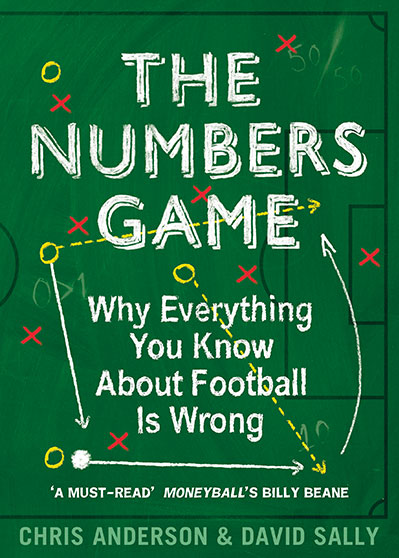IoT in Sports: The Numbers Game

Excessive collection of statistical data is at the heart of a huge sports trend. As if crunching and interpreting vast amounts of performance-related information will allow you to look into the future. Where humans seem to be limited, artificial intelligence might actually do the trick.
In some of its best moments, the game of basketball transcends its skillful grind to become something beautiful. It looks like an unchoreographed dance in squeaky sneakers. Its rhythm and movements drawn from the art of improvisation: impromptu, unprogrammed – and, yet, deliberate.
This has taken some time. The early game, invented a hundred years ago, was a fairly rigid, static, and structured pursuit. Only recently has it reached what psychologists call “flow state” – and only because of the men who shaped it over time. The players had roots in the same ethnic enclaves as jazz, and it was Black America that turned a team contest into an entertaining show of masculinity.
At the same time as black players ascended, the game branched out intellectually into another dimension.It became a laboratory for mathematicians who like to measure all that creativity and spontaneity and break the aspirations down into calculations, probabilities, and outcome predictions. That is why the National Basketball Association (NBA), one of the most successful sports leagues in the world, is in possession of a massive archive of individual performance data. What the league started to put on a website a couple of years ago is updated constantly and be-comes available to the general public five minutes after each game, The sophisticated statistics platform was created by software giant SAP but, initially, a few usability issues had to be solved. How can you serve tens of thousands of users at the same time? How do you present and help navigate billions of different data combinations? How do you make this stimulating for the regular fan?

With a computer like Deep blue, the fascination with sports would be lost.
Holger Geschwindner, Basketball player and manager
Apart from interesting the fans, the service is also a valuable toolbox for coaches who like to see indisputable facts which they can study for patterns, interpret into strategy, and convey to their players. The game has provided a vault of untapped secrets, ready to reveal unexpected insights into opponents and their weaknesses and into options to build better teams.
Deep Blue Yonder
The early influencers in basketball were talented mavericks with playful nicknames like Julius “Dr J” Erving, Earl “The Pearl” Monroe, and Earvin “Magic” Johnson. Until a certain Michael (Mike) Jordan came along and convinced the masses that his show was no act at all – it was the real deal. A force of personality which personified ambition and artistry in one.
Today’s generation of players might have never heard the slogan “Be Like Mike” but they understand its meaning. To be a true superstar in sports you have to be you. You can’t just be a number or a “showboat,” the unflattering nickname the late, great Kobe Bryant was given by his peers when he began playing in the NBA.

Total Control: The NBA 2K game-play series simulates real-life NBA basket-ball games, with the players using their consoles to control entire teams or selected athletes (source ©: pcmgamers.com).
Interestingly most of the coaches were white and were not only trying to master the art of winning but were also concerned about their role as authority figures in a sport of self-aware, confident black players.
The coaches’ main interest was, and remains, in plain numbers, such as points gained or lost, throwing attempts, rebounds, assists, and blocks. Adding them or dividing them by games played or by minutes elapsed allowed them to distill a few key messages related to individual players’ performances. Curiously, especially in the US, ardent fans, driven by a similar analytical mindset, have become interested in this kind of data and their coach-centric viewpoint has been packaged and sold in the form of sports video games, such as the annually updated NBA 2K series, which first came out in 1999. The gameplay simulates real-life NBA basketball games, with the players using their consoles to control entire teams or selected athletes.
Holger Geschwindner, the basketball mentor and manager who guided the 20-year career of Dirk Nowitzki, one of the best players in the history of the league, has never shied away from an analytical approach. Hardly surprising as he has college degrees in mathematics and physics. He was also a pretty good basketball player himself and captained the German national team at the 1972 Olympics in Munich. He doesn’t want sports to go “in the direction of robots” but to become even “more beautiful and more artistic.”

We get better and better at it over time.
Alan McCabe, James Cook University
“There has to be such a combination. I can’t imagine that it would be exciting for spectators to watch games that look more like chess. With a computer like Deep Blue [the famous IBM chess-playing supercomputer], the fascination with sports would be lost.
“This has not been much of a concern for Alan McCabe, who works at the School of Information Technology at James Cook University in North Queensland, Australia. He started to explore the statistics from a betting viewpoint by modeling elements of sporting contests. “We get better and better at it over time,” he says – to the point where he was able to outperform most of the expert punters.
His work has gained quite an audience. He started with information from the Australian National Rugby League and then expanded into other fields, including English Premier League (EPL) soccer. In his first EPL run, he claimed a prediction accuracy of 53.2 percent and last season, which was interrupted in April due to Co-vid-19, saw him push up his outcome success rate to about 60 percent.
Early on, he began to integrate learning algorithms into his calculation models to optimize the weights within a multilayer perceptron, such as back-propagation, the conjugate gradient method, and classical algorithms, McCabe explained in one of his papers. These are fundamental practices in neural networks which, crudely put, amounts to learning from your mistakes.
Luck be a Lady
The use of machine learning techniques to predict probabilistic events is something the sports betting industry finds just as intriguing as the addicted public. On any given day either opponent can score and win a game – regardless of common-sense expectations, the complex element of “luck” always plays a part. It is what makes the prediction process difficult and attractive at the same time. To sort through the mountains of statistics and cut the data down to reasonable probabilities is tricky and it inspired American sociology professor William Bruce Cameron to coin the aphorism: “Not everything that counts can be counted, and not everything that can be counted counts!
“It is this conundrum that’s at the heart of the statistical craze in team sports. In reference to soccer, two experts in economic theory, social science, and statistics, Chris Anderson and David Sally, laid all of this bare in 2013 in a book titled The Numbers Game and subtitled Why Everything You Know About Soccer Is Wrong.
Anderson has been thinking about the subject for a long time. The son of a member of the American occupation forces, he grew up in Germany and was a goalkeeper in a fourth-tier German soccer team. At the time the book was published, he was a professor at Cornell University in New York State but he now teaches in the European Institute at the London School of Economics.
Anderson likes to point out “misjudgments” which afflict everybody, especially live-TV broadcasters and the public at large, who seem to perpetuate the myth of categories that are less relevant than they seem. “For example, possession of the ball. This category contains relatively little information on how successfully a team plays. Corner kicks are also a great example. They produce hardly any advantages. We know this from all the statistics,” Anderson says.

Faulty Assumptions: There is no truth in this sense. In football and other sports. Those who succeed are those who understand how to combine the numbers with other ways of observing games.
“The danger is that you really start believing your own statistics,” he cautions. “There is no truth in this sense. In football and other sports. Those who succeed are those who under-stand how to combine the numbers with other ways of observing games.
“Wrong assessments can have fateful consequences. Take the decision makers at soccer clubs, for example. They spend most of the big bucks hiring promising strikers – an investment which ignores the importance of the role of talented defenders. No wonder – in a game in which statistics are mainly drawn from attacking and pushing forward, evaluations of the qualities of defensive players is hard to come by. How do you measure the success of somebody who chases his opponents, is really fast, and can anticipate developing situations better than others? “Defense is about preventing things. About warding off moments of danger,” Anderson explains. “Goals that you prevent are most important for your success. But these accomplishments are not reflected anywhere in the statistics.”
Beane Counting
The belief system of the numbers nerds borders on religion. Think of Billy Beane, a long-time baseball manager with the Oakland Athletics, who hired players based on a sophisticated evaluation scheme. His ultimate goal was to be competitive against teams that were filthy rich and willing to spend limitless amounts on salaries. The author Michael Lewis labeled Beane’s efforts Moneyball, turned the story into a bestseller, and was rewarded when Hollywood actor Brad Pitt picked it up and created an even more famous movie. Its mind-opening line was: “The problem we’re trying to solve is that there are rich teams and there are poor teams. Then there’s fifty feet of crap, and then there’s us. It’s an unfair game.
“What were the flaws of Beane’s system? First, he never went on to win a World Series championship. As smart as his system was in finding underappreciated pieces for his puzzle, it wasn’t enough. Richer teams constantly sucked enough top-quality talent in to prevail. Second, when the Moneyball book made its rounds most other teams were intelligent enough to study Oakland’s statistical approach and copy it. Data mining became so big in Major League Baseball that, in 2013 and 2014, Chris Correa, the scouting director of the St. Louis Cardinals, hacked the computer system of the Houston Astros, a competing team. The Astros, who had been pretty bad for quite some time, suddenly became really good – which raised a suspicion that the executive might have taken valuable company secrets with him when he left. The scouting director was prosecuted for the hack and sentenced to 46 months in prison.
Worth a Flutter
It is no secret who, beyond teams and their scouting and coaching departments, profits from data mining. The biggest investors in generating algorithms for use in whipping up a secret sauce for predicting games are betting companies. “Artificial intelligence is changing the sports bet-ting game,” noted Science101.com, an American website which looks at pioneering science and discoveries.

The danger is that you really start believing your own statistics.
Chris Anderson and David Sally
In June 2019, in a long exposé about the development, Science101 examined Monster Roster, a platform cooked up by Dylan Elder, “a 22-year-old math whiz,” who started the company four years earlier when he was still in high school. His thing? Machine learning and artificial intelligence that continuously tracks players in all professional sports through-out their seasons. The article also mentioned Israel-based WSC Sports, a company producing sports video content “in a simplified and automated way that can be used for broadcast highlights and social media distribution.” The company told 101’s reporter Brian O’Connell: “With AI and machine learning technology, you can better target to drive more engagement, which equals more betting.” This gave the magazine reason to claim there is an “organic symmetry be-tween gambling and high-end number-crunching and data analysis.

Setting Things Right: In their book, Anderson and Sally point out “typical misjudgments” which afflict everybody, especially live-TV broadcasters and the public at large, who seem to perpetuate the myth of categories that are less relevant than they seem.
Information: Anderson & Sally
“Information exposed by these specialty companies will filter into different realms. It is sought after by teams in the big leagues, where billions of dollars are at stake. It trickles down to people on social media platforms trying to keep in touch with any imaginable nuance of the games while they are played. It is also being picked up by TV commentators, often in real time to enhance live broadcasts, and it inspires leagues like the German Bundesliga to do their own research and feed data into fans’ handheld devices while the game goes on right in front of their noses.
In return, in places like the US where sports betting, illegal for over a century, has been green-lighted recently, many interested parties have grown an appetite for cashing in on the action. It is not just governments who are increasing their revenues by taxing the betting market; the big leagues are just as greedy. That said, their arguments do sound reason-able when they explain why they want to be rewarded: the games only exist because they put them up – and the games must go on.

Sign up for the Avnet Silica Newsletter!
Stay up-to-date with latest news on products, training opportunities and more!

Take a DEEP look into the future!
Get the latest market trends and in-depth trainings on our Digital Event Experience Portal!

Avnet Silica Design Hub
Browse and review hundreds of proven reference designs to accelerate your design process. Our designs can be modified and saved in our AVAIL design tool and then exported to your CAD tool of choice.



